Chapel Artwork
Granlund Doors and Sculptures
Bronze pieces created by Gustavus Adolphus College sculptor-in-residence Paul T. Granlund enhance Christ Chapel and its surroundings both artistically and theologically.
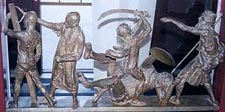
West Entrance: The Old Testament Door
Within the west entrance, the Old Testament Door, is a sculptural frieze portraying the stories of Adam and Eve, Noah, Abraham, Jacob, Moses, Joshua, David, Solomon, Elijah, Josiah and finally, at the center, Isaiah and John the Baptist pointing to the Lamb of God. The outside door carries a creation motif.
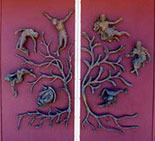
North Entrance: The Christ Door
The handles of the north entrance, the Christ Door, are themselves a part of the sculptural Christian timepiece of which the figures, running counterclockwise, are the seven major points of the Creed's Second Article: crucified, died, buried, descended, rose again, ascended and reigns. The figures are unified by a tree lifeless on one side, symbolizing dormancy and death, with foliage emerging on the other side, symbolizing new life in Christ. Inside panels treat the themes of Baptism and the Lord's Supper.

East Entrance: The New Testament Door
The east entrance, the New Testament Door, bears sculpture that is a visual metaphor for the scriptural passage, "I am the vine and you are the branches." The four branches reflect the seasons of life. Inside panels celebrate the birth of the church - the apostle Paul and the Pentecost story - as well as the lives of New Testament and Modern Saints, including Mother Teresa, Albert Schweitzer, Teilhard de Chardin, Johann Sebastian Bach, Gustav II Adolph, Martin Luther, Johannes Gutenberg, St. Jerome, Hildegaard von Bingen, Polycarp, St. Ansgar, King Bjorn, St. Francis of Assisi, St. Birgetta with her daughter Catherine, Eric Norelius, Edgar Carlson, Campanius, Muhlenberg, Martin Luther King Jr., Dag Hammarskjold, and Raold Wahlenberg.
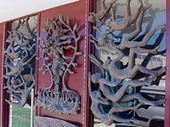
South Entrance: The Hope Door
The south entrance, the Hope Door, depicts the final moment of existence. Free yet united figures of the family of believers, those attracted by Christ's righteousness, float toward a triumphant, welcoming Christ. Below, those repelled by righteousness recede into isolation in solid bronze.
Other sculptures
Four Granlund sculptures grace the Christ Chapel grounds. To the west, Palindrome, the memorial fountain honoring Bishop Melvin Hammarberg, says in classic Greek characters, "Wash your iniquities, not only your face." Crucifixion, on the Eckman Mall side of the chapel, is a gift from former Gustavus Adolpus College President Edward Lindell and his wife Patricia. To the east, Luna Moth Matrix, a metaphor of the promise of resurrection and renewal, celebrates the membory of Douglas Sandberg. On the southwest corner of the chapel lawn, St. Francis dances on the moon and looks through the sun/Son at the risen Christ. This sculpture, given by the Anderson family in memory of Ren and Sylvia Anderson who directed the Office of Public Relations, is based on the Canticle of Brother Sun.
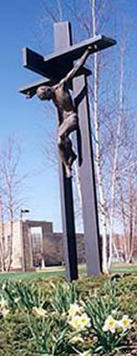

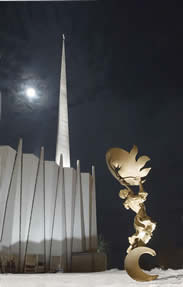
Paraments
 In 2016, Christ Chapel received new paraments for the first time in more than forty years to highlight the natural beauty of Gustavus Adolphus College. The paraments are large, gold pieces of cloth with metallic painted liturgical designs created by Minnesota artist Chillon Leach. The three paraments include a depiction of the Minnesota River as it curves around Saint Peter, a forest representing the Linnaeus Arboretum, and a prairie. “The pieces have a sense of wind and movement in the trees and prairie, to honor the ‘Gusties’ because the wind is so present on campus. It also represents the vitality of the campus and the presence of a moving, creative Holy Spirit,” Leach said.
In 2016, Christ Chapel received new paraments for the first time in more than forty years to highlight the natural beauty of Gustavus Adolphus College. The paraments are large, gold pieces of cloth with metallic painted liturgical designs created by Minnesota artist Chillon Leach. The three paraments include a depiction of the Minnesota River as it curves around Saint Peter, a forest representing the Linnaeus Arboretum, and a prairie. “The pieces have a sense of wind and movement in the trees and prairie, to honor the ‘Gusties’ because the wind is so present on campus. It also represents the vitality of the campus and the presence of a moving, creative Holy Spirit,” Leach said.
Before she designed the pieces, Leach spent time in Christ Chapel so she could truly understand the environment. “I stayed all afternoon in the chapel and watched how the natural lighting changed and moved in the sanctuary on a windy, cloudy December day. People came in to practice on the grand piano and then the organ; there were Christmas trees delivered and tours given. It is a place of life,” Leach said.
For more information, visit https://news.blog.gustavus.edu/2016/11/07/minnesota-artists-designs-new-paraments-for-christ-chapel/
Font

The Baptismal Font in Christ Chapel was done by Professor Donald Gregory, an original member of the art department at Gustavus. The inspiration for the font design came from the Swedish May Baskets his mother used to make. They were folded in fours, a shape which echoes the shape of the Chapel itself.
The figures are symbolic of Martin Luther’s three points of baptism. The first, the ‘sign’, is symbolized by the water coming from a shell held by one of the four sculptured figures. The second point is ‘significance’, represented by two figures, the drowning of the “old Adam” in humans and our transfiguration. The fourth figure symbolizes ‘faith’-the third point in Luther’s doctrine.
Each of the four bronze figures is set in the stone font at the entrance to Chapel. Liturgically the placement represents “entering the Church through Baptism” and passing by the font can serve as a symbol of rededication each time one enters, touches the water and marks themselves with the water making the sign of the cross.
Candelabra
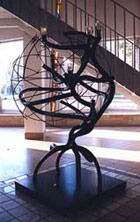
The candelabra was placed by former Gustavus President John Kendall in recognition of his father Leonard Kendall's contributions to the college and the chapel. Words near the votive candelabra in the Cathedral in Uppsala, Sweden also grace the Christ Chapel candelabra:
Ljus for Andra
Lägg en gåva och tand ett ljus.
Bed en kort bön, om du kan, för någon
du håller av, eller någon som behöver
se Guds ljus i sitt liv.
Light for Others
Make a gift and light a candle.
Pray a short prayer, if you can, for
someone you love, or someone who needs
to see God's light in his life.
King's Altar Cloth
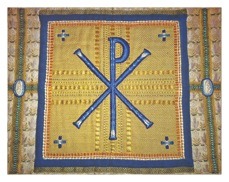
At the Festival Worship Service during the October 5, 2012 Royal Visit included the blessing and dedication of new paraments for Christ Chapel officiated by Bishop Ake Bonnier of the Skara Diocese, Sweden, in the presence of Their Majesty King Carl Gustaf XVI and Queen Silvia of Sweden. The Paraments included an altar cloth entrusted to Gustavus, which was designed and needlepointed by His Majesty the King’s great-grandfather King Gustaf V of Sweden, an avid needlepointer. The altar cloth was originally given to Bethlehem Lutheran Church in Brooklyn, N.Y., in 1948 when the Rev. Martin L. Cornell served as pastor and was first dedicated on May 22, 1949, as part of the Church’s 75th anniversary service. Bethlehem Lutheran, a large congregation, was active in welcoming Swedish immigrants as well as starting the Swedish Augustana Home for the Aged, and served as the first home of Upsala College.
In 2007, when longtime Bethlehem member Marion Palm was at Gustavus for the graduation of her son, Noah, she connected with Elsa Cornell ’61, daughter of Pastor Cornell. Since Bethlehem Lutheran was being dissolved as a congregation, the future home for the altar cloth was of great concern. We thank Marion Palm and Elsa Cornell for initiating the process of relocating and preserving the altar cloth.
A committee was established by Kris Ohle to determine how best to present the altar cloth. The group felt that the cloth should be combined with undercloths on the altar and that a complete set of paraments should be designed to feature the “King’s” altar cloth. The committee included the College’s chaplains, Barbara Larson Taylor, assistant to the president for special projects, and designers Jennifer Kurth and Neely Prenzlow from Gustavus’s Office of Marketing and Communication. The new paraments and undercloths were crafted by area artisan Joan Miller.
Gustavus is honored to be the caretaker of such a treasured piece of art. The new Christ Chapel paraments are used on special occasions and in the Christmas and Easter seasons of the liturgical year.
Taizé Cross

The Taizé cross used in Christ Chapel is made from two posters that reproduce the icon of the crucified Jesus, painted by Brother Eric of Taizé, that is in the Church of Reconciliation in the Taizé Community of France. Gustavus carpenters created the wooden framework to which the posters are varnished so that the cross matches the rest of the wood in the Chapel. The Taizé cross icon is used as a focal point for the worship community at the monthly Taizé services held during daily Chapel. The Confer Family Chapel Fund made the purchasing of materials and labor for the Taizé cross icon possible.
"Christ Crucified, Christ Enthroned" Processional Cross
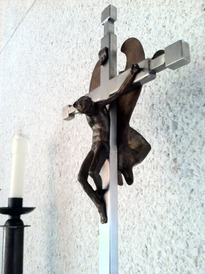
From the dark dimension of the crucifixion to the bright dimension of the resurrection, the composition is mounted to suggest Christ’s passage through the mystery that separates dimension – from death to resurrection. The winged form which separates the figure represents the Holy Spirit. The most interesting aspect is the curious juxtaposition of the two figures placed as they are on front and back of the cross, according to its creator, Don Gregory.
"As we view the crucifixion, we find it shadowed by the dark wings of the Holy Spirit. When viewing the enthroned, the cross disappears and the wings become the throne. The cruciform shaft is of stainless steel; the figures are bronze." —Don Gregory
"Listening" Christ Chapel ceramic piece

Lois Peterson is a professor of studio arts at Gustavus and a ceramicist. Peterson is deeply influenced by the monophonic sacred song of the middle ages. She notes that the clarity and austerity of Gregorian chant motivated her to shift her compositional approach to utmost simplicity.
Peterson’s installation is created from unglazed white stoneware. It has been stripped of colors, symbols and subjects so that the viewer focuses the abstract pattern of lines and shapes. Viewers are invited to share a state of quietude and contemplation, a inner state that Peterson considers fundamental to eastern religions as well as to western spirituality.
Peterson designed a site-specific artwork. The slanting columns in the installation mirror the thin stained glass panels that rise through the chapel in diagonal lines. The artwork is installed on the wall of the balcony, the setting for the organ and choral music of the chapel.
"Community of Believers"
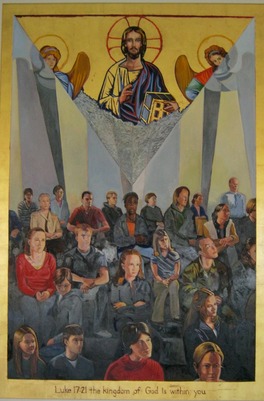
Artist Bill Bukowski had a group of students, faculty and staff come together in the chapel after a service and took photos of the group. He created a piece based on these photos that hangs in the chapel.
Bukowski stated about the piece that “One of the early portraits of Jesus Christ has come from the Byzantine world and I wanted to pay tribute to the early Christians with the portrait of Jesus with angels. I use shapes that suggest the lines of this chapel as well as show a visual transition from the group of Gustavus people.
"Some of the crowd are depicted smaller and some are clearer and it was painted like that to suggest the strength of their faith. As a community, we all have variables difficult to measure and well as faith is impossible to measure.
"The quote is meant help viewers remember that the kingdom of God is within us. It is written in a rustic style as in the catacombs or gathering places of the early faithful.
"The piece is painted on wood with oil and gold leaf. I wanted to use some traditional materials to also connect with the great art of the past.”
Chalice

The large bronze chalice was designed in two parts: an octagonal base and a bowl holding a simple cup.
The chalice has on each side of the bowl eight figures representing the life of Christ. The base has eight natural objects, corresponding to each phase of Christ’s life, symbolizing them.
Occasionally the chalice is on the Altar during Holy Communion.
“Gregory created this very elegant piece - baroquish, renaissance - transmits a feeling for the centuries of communion that have given Holy Communion its meaning,” said Chaplain Richard Elvee. “It is luxurious and can be associated with a cathedral.”